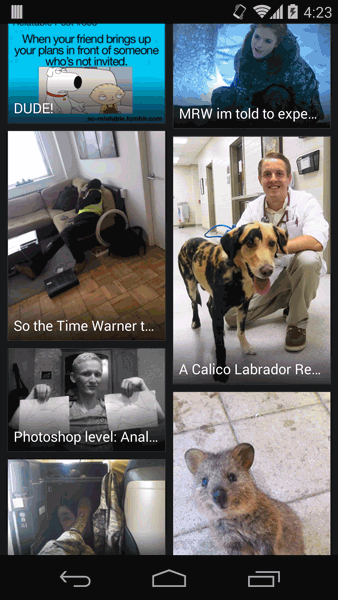A sample Android app which showcases advanced usage of Dagger among other open source libraries.
Watch the corresponding talk or view the slides.
The ObjectGraph is created in the U2020App's onCreate method. The Modules class provides a
single method, list, which returns the list of module instances to use.
In order to add functionality in the 'debug' version of the app, this class is only present in the
release/ and debug/ build type folders. The 'release' version only includes the U2020Module while
the 'debug' version includes both U2020Module and DebugU2020Module, the latter of which is only
present in the debug/ build type folder and is an override module.
Through the use of Dagger overrides, the 'debug' version of the app adds a slew of debugging features to the app which are presented in the Debug Drawer™. The drawer is opened by a bezel swipe from the right of the screen. From here you can change and view all of the developer options of the application.
The drawer is provided by the simple interface AppContainer. This is an indirection that the
single activity uses to fetch its container into which it can place its content. The default
implementation returns the Android-provided content view. The 'debug' version overrides this with
DebugAppContainer which is responsible for creating the drawer, adding it to the activity, and
returning its content view group. It also injects all of the developer objects and binds them to
controls in the drawer.
The most notable feature the 'debug' version exposes is the concept of endpoints. Using the spinner at the top of the drawer, you can change the endpoint to which the app communicates. We also expose a false endpoint named "Mock Mode" which simulates an in-memory server inside the app. This "Mock Mode" eases manual testing and also provides a static set of data to write instrumentation tests against.
"Mock Mode" can be queried when modules are configuring their dependencies which is what allows simulating the remote server in-memory.
@Singleton class MockFoo() {
@Inject MockFoo() {}
// ...
}@Provides @Singleton Foo provideFoo(@IsMockMode boolean isMockMode, MockFoo mockFoo) {
return isMockMode ? return mockFoo : new RealFoo();
}See DebugDataModule and DebugApiModule to see this in action in the real app.
The mock implementations of these types are some of those injected into the DebugAppContainer for
binding in the drawer. This allows us to do things like control their fake network behavior and
alter their behavior.
In order to keep the shared state which represents the server-side data we use a ServerDatabase
singleton. At present this is only done with a combination of in-memory collections and images in
the debug/assets/. In a more complex app you could even use a full database. This class is
injected into each mock service which uses its methods to query and mutate state
(e.g., MockGalleryService).
- Dagger - http://square.github.io/dagger
- ButterKnife - http://jakewharton.github.io/butterknife
- Retrofit - http://square.github.io/retrofit
- Picasso - http://square.github.io/picasso
- OkHttp - http://square.github.io/okhttp
- RxJava - https://github.com/ReactiveX/RxJava
- Timber - http://github.com/JakeWharton/timber
- Madge - http://github.com/JakeWharton/madge
- Scalpel - http://github.com/JakeWharton/scalpel
- StaggeredGrid - https://github.com/etsy/AndroidStaggeredGrid
- Something with animations to showcase animation control.
- Network errors probably crash the app.
- Add another part of the app other than 'gallery' so we can demo child graphs.
- Kill Etsy view in favor of RecyclerView
- Toss column count into dimen and scale appropriately.
- Controls to change which gallery we're looking at?
Copyright 2014 Jake Wharton
Licensed under the Apache License, Version 2.0 (the "License");
you may not use this file except in compliance with the License.
You may obtain a copy of the License at
http://www.apache.org/licenses/LICENSE-2.0
Unless required by applicable law or agreed to in writing, software
distributed under the License is distributed on an "AS IS" BASIS,
WITHOUT WARRANTIES OR CONDITIONS OF ANY KIND, either express or implied.
See the License for the specific language governing permissions and
limitations under the License.
